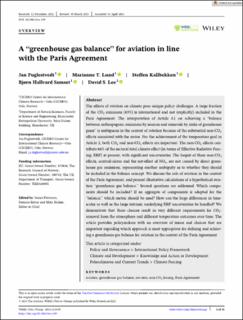| dc.contributor.author | Fuglestvedt, Jan S. | |
| dc.contributor.author | Lund, Marianne Tronstad | |
| dc.contributor.author | Kallbekken, Steffen | |
| dc.contributor.author | Samset, Bjørn Hallvard | |
| dc.contributor.author | Lee, David S. | |
| dc.date.accessioned | 2024-03-04T11:38:48Z | |
| dc.date.available | 2024-03-04T11:38:48Z | |
| dc.date.created | 2023-06-26T08:21:34Z | |
| dc.date.issued | 2023 | |
| dc.identifier.citation | Wiley Interdisciplinary Reviews: Climate Change (WIRESs). 2023, . | en_US |
| dc.identifier.issn | 1757-7780 | |
| dc.identifier.uri | https://hdl.handle.net/11250/3120872 | |
| dc.description.abstract | The effects of aviation on climate pose unique policy challenges. A large fraction of the CO2 emissions (65%) is international and not (explicitly) included in the Paris Agreement. The interpretation of Article 4.1 on achieving a “balance between anthropogenic emissions by sources and removals by sinks of greenhouse gases” is ambiguous in the context of aviation because of the substantial non-CO2 effects associated with the sector. For the achievement of the temperature goal in Article 2, both CO2 and non-CO2 effects are important. The non-CO2 effects contribute 66% of the sectoral total climate effect (in terms of Effective Radiative Forcing; ERF) at present, with significant uncertainties. The largest of these non-CO2 effects, contrail-cirrus and the net-effect of NOx, are not caused by direct greenhouse gas emissions, representing another ambiguity as to whether they should be included in the balance concept. We discuss the role of aviation in the context of the Paris Agreement, and present illustrative calculations of a hypothetical aviation “greenhouse gas balance.” Several questions are addressed: Which components should be included? If an aggregate of components is adopted for the “balance,” which metric should be used? How can the large differences in timescales as well as the large intrinsic underlying ERF uncertainties be handled? We demonstrate that these choices result in very different requirements for CO2-removal from the atmosphere and different temperature outcomes over time. The article provides policymakers with an overview of issues and choices that are important regarding which approach is most appropriate for defining and achieving a greenhouse gas balance for aviation in the context of the Paris Agreement. | en_US |
| dc.language.iso | eng | en_US |
| dc.rights | Navngivelse 4.0 Internasjonal | * |
| dc.rights.uri | http://creativecommons.org/licenses/by/4.0/deed.no | * |
| dc.title | A “greenhouse gas balance” for aviation in line with the Paris Agreement | en_US |
| dc.title.alternative | A “greenhouse gas balance” for aviation in line with the Paris Agreement | en_US |
| dc.type | Peer reviewed | en_US |
| dc.type | Journal article | en_US |
| dc.description.version | publishedVersion | en_US |
| dc.source.pagenumber | 0 | en_US |
| dc.source.journal | Wiley Interdisciplinary Reviews: Climate Change (WIRESs) | en_US |
| dc.identifier.doi | 10.1002/wcc.839 | |
| dc.identifier.cristin | 2157682 | |
| dc.relation.project | EU/875036 | en_US |
| dc.relation.project | Norges forskningsråd: 300718 | en_US |
| cristin.ispublished | true | |
| cristin.fulltext | original | |
| cristin.qualitycode | 1 | |

